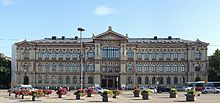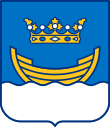Finnish National Gallery
- Machine translation, like DeepL or Google Translate, is a useful starting point for translations, but translators must revise errors as necessary and confirm that the translation is accurate, rather than simply copy-pasting machine-translated text into the English Wikipedia.
- Do not translate text that appears unreliable or low-quality. If possible, verify the text with references provided in the foreign-language article.
- You must provide copyright attribution in the edit summary accompanying your translation by providing an interlanguage link to the source of your translation. A model attribution edit summary is
Content in this edit is translated from the existing Finnish Wikipedia article at [[:fi:Kansallisgalleria (Suomi)]]; see its history for attribution. - You may also add the template
{{Translated|fi|Kansallisgalleria (Suomi)}}to the talk page. - For more guidance, see Wikipedia:Translation.
 | |
| Formation | 2014 |
|---|---|
| Founder | Finnish Art Society |
| Type | Art museum institution |
| Headquarters | Helsinki, Finland |
| Website | Official Website |

Finnish National Gallery (Finnish: Suomen Kansallisgalleria, Swedish: Finlands Nationalgalleri) is the largest art museum institution of Finland. It consists of the Ateneum, an art museum; Kiasma, a contemporary art museum; and the Sinebrychoff Art Museum, a historic house and art museum.[1]
The organization's functions are supported by the conservation department, the administration and services department and Kehys, the art museum development department.
History
On January 27, 1846, the Finnish Art Society was established. In 1848, it established the Helsinki Drawing School and in 1852, the organization took over Turku Drawing School.
In the 19th century, the organization's collections grew through donations. In 1893, Victor Hoving [sv], Herman Antell [fi], and Karl Emanuel Jannsson made significant contributions to the organization.
The Ateneum building was completed in the spring of 1887 and the Finnish Art Society's operations were moved there. In 1921, Paul and Fanny Sinebrychoff donated approximately 900 works to the Society, creating the basis of what would become the Sinebrychoff Museum.
In 1939, the Fine Arts Academy of Finland was established. That same year, the Ateneum art collection and Sinebrychoff Museum were closed due to the Winter War. The Ateneum art collection reopened in 1946 and was renamed the Ateneum Art Museum in 1958. The Sinebrychoff Museum reopened in 1960.
In 1990, the Finnish National Gallery was established to manage the collection. That same year, the Museum of Contemporary Art was founded. In 1996, construction of a building for the Museum of Contemporary Art began and in 1998, the Kiasma opened.
In 2014, the Finnish National Gallery reorganized as a public foundation that operates the Ateneum Art Museum, Museum of Contemporary Art Kiasma, and Sinebrychoff Art Museum as museum units.[2]
Functions
The mission of the Finnish National Gallery is to further the cultural heritage of Finnish visual arts, to enforce the significance of visual culture in contemporary times, and to develop the art museum industry. They also maintain and develop Finland's largest collection of art and the knowledge and research archives of their field.
Collections
The Ateneum is a predominantly Finnish Art Museum with paintings by leading Finnish painters like Albert Edelfelt, Eero Järnefelt, Helene Schjerfbeck, Pekka Halonen, Hugo Simberg, Akseli Gallen-Kallela, and Fanny Churberg. The Sinebrychoff Art Museum has foreign paintings by painters such as Giovanni Boccati, Giovanni Castiglione, Govaert Flinck, Rembrandt, Jan Cook, Goyen, Carl Wilhelm de Hamilton, Lucas Cranach the Elder, Jurgen Ovens, Frans Wouters, Hieronymous Francken the Second, Joshua Reynolds, Antoine Watteau, François Boucher, Carl Von Breda, Alexander Roslin, and Jacob Bjorck. It has an appreciable collection of Swedish miniatures.
See also
References
External links
- The website of the Finnish National Gallery
- The Ateneum Art Museum
- The Museum of Contemporary Art, Kiasma
- The Sinebrychoff Art Museum
- v
- t
- e

- Temppeliaukio Church
- Helsinki Cathedral
- Uspenski Cathedral
- St. Henry's Cathedral
- St. John's Church
- St. Mary's Church
- St. Paul's Church
- Mikael Agricola Church
- Holy Trinity Church
- Church of Christ
- Finnish Methodist Church
- Old Church
- Kallio Church
- Kulosaari Church
- Suomenlinna Church
- Töölö Church
- Viikki Church
- Kamppi Chapel
| Theatres | |
|---|---|
| Music venues |
| Events |
|---|
60°10′18″N 24°56′13″E / 60.1717°N 24.9369°E / 60.1717; 24.9369
  | This article about a museum in Finland is a stub. You can help Wikipedia by expanding it. |
- v
- t
- e
 | This article about a Finnish building or structure is a stub. You can help Wikipedia by expanding it. |
- v
- t
- e










